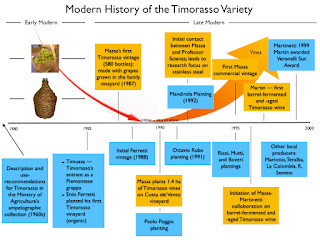While the Early Modern history of the Timorasso variety was characterized by decline, despair, invisibility, and replacement, its Late Modern history saw a turnaround in fortunes, much of which, according to widely held views, was attributable to the efforts of Walter Massa. In this post I take a deeper look into the experiences of the variety in the period just before, during, and after, the last decade of the 20th century.
I have written previously on Massa's accomplishments, beginning with his initial 1987 vintage. But looking back at the Early Modern history, one cannot help but (i) note that Enio Ferretti had planted an organic Timorasso vineyard in the region in 1985 and (ii) wonder how much this had influenced Massa's decision to seek out grapes and vinify a wine from this variety.
Ferretti's initial harvest dropped in 1988, the same year he left the Valle Unite Cooperative. The results of the initial planting raised a number of questions about the project within the organization (Quiligotti):
- The position of the vineyard, and the soil, were not optimal for Tinmorasso
- It turns out that the vine gives its best performance when planted on poor soils on sunny, well-ventilated ridges (the latter serving as a natural protection against rot)
- There was uncertainty as to how best to work the vines
- Improper vineyard workings increased the potential for rot.
These problems were only corrected by a second planting in 1996.
Massa, convinced of the potential of a Timorasso wine by the results of his initial vintage, planted 1.4 ha of Timorasso vines in the Costa del Vento vineyard in 1990. He was followed shortly after by Ottavio Rube (one of the founders of Valle Unite), who planted his Timorasso vines in 1991. Mandirola planted its Lù delle Costa field to Timorasso in 1992.
It was also in 1992 that we saw the "first great recognition of Timorasso wine." Attilio Scienza, the renowned Professor of of Viticulture and Enology at the University of Milan, tasted a Massa Timorasso while out dining and was so impressed that he reached out to the winemaker in a telephone call. Subsequent meetings led to a collaboration on research and zoning paths (Quiligotti) with a focus on stainless steel vinification and aging of the wine.
In 1996 Massa and Franco Martinetti (the same Martinetti that was involved in the Timorassa grappa of 1985) "began to exchange some considerations on this vine and both decided to give a decisive acceleration in favor of quality by experimenting with rigorous and effective viticulture and oenological techniques ..." The collaboration resulted in trials (at the Massa facility) wherein Timorassa grapes were vinified and aged in barriques and, eventually, a 1997 barrel-fermented and -aged wine being given the nomenclature Martin (Brozzoni).
According to Brozzoni, the Veronelli Guide began to follow the path of the two fermentation/aging regimes, using Massa's 1996 Colli Tortonesi Bianco Costa del Vento and Martinetti's 1997 Colli Tortonesi Bianco Martin as the starting points. Luigi immediately "fell in love" with the Martin and eventually awarded the 1999 edition the coveted Sun Award.
But Massa was not only interested in Timorasso for his own account. He began to proselytize to anyone that would listen. Daniele Ricci worked as his understudy and acolyte and learned everything that he could from Massa before going off and founding his own winery in Casca Vescovato. This 1.5-ha vineyard, named Vigna di Carlo, was planted in 1995. Andrea Mutti and Luigi Boveri also planted their Timorassos in 1995.
Elisa Semino, now of La Colombera, did her thesis on the Timorasso variety and, according to Walter, worked at his estate in 2000 while collecting data for her study. After graduation, Elisa and her dad were among the first five Colli Tortonesi wineries to heed Walter's Timorasso call.
Walter went on to mentor a large number of the small farmers in the region who saw his success and wanted to replicate it in their environments. They formed an association organized around Massa's production principles and met regularly to compare notes and taste each other's wines.
The Late Modern history of Timorasso is summarized below as a part of a larger depiction of the modern history of the variety.
The Late Modern production regime, based on the Massa process, is as follows:
- Hand-harvesting
- Maceration on the skins
- Soft pressing
- Fermentation with indigenous yeasts in stainless steel tanks (20 - 25ºC)
- Spontaneous malolactic fermentation after temperature reduced to 10 - 18ºC
- Wine aged in stainless steel tanks for one year (with batonnage)
- Light filtration prior to bottling
- Minimum 6 months bottle aging.
I will address the Post-Modern history of the variety in a subsequent post.


























